The High Speed Blowers Market is estimated to be valued at USD 950.5 million in 2025 and is projected to reach USD 1462.1 million by 2035, registering a compound annual growth rate (CAGR) of 4.4% over the forecast period. Between 2020 and 2030, the market value rises from USD 766.4 million to around USD 1,129.2 million, marking a steady upward trend fueled by growing demand across diverse industrial applications such as HVAC, manufacturing, chemical processing, and power generation.
This initial growth phase benefits from increasing investments in infrastructure development, stringent emission regulations, and the need for energy-efficient and high-performance blower systems that optimize airflow and reduce operational costs. Technological advancements in blower design, including improved aerodynamics, materials, and noise reduction features, further drive market expansion.
From 2030 to 2035, the market accelerates from USD 1,178.9 million to USD 1,462.1 million, supported by the rising adoption of smart and IoT-enabled blower systems that offer enhanced control, monitoring, and predictive maintenance capabilities.
Emerging economies demonstrate rapid uptake due to industrial growth and urbanization, while developed markets focus on upgrading aging equipment and adopting environmentally friendly solutions. Overall, the high-speed blowers market is positioned for consistent and sustained growth through 2035, driven by technological innovation, regulatory compliance, and increasing demand for efficient industrial airflow management.
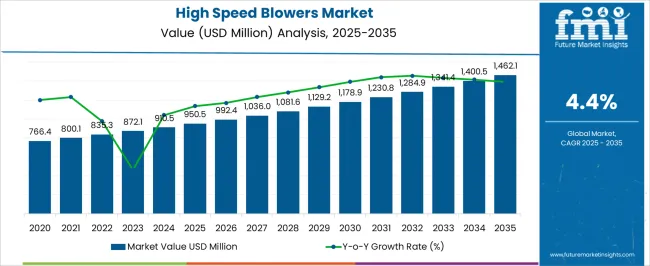
| Metric | Value |
|---|---|
| High Speed Blowers Market Estimated Value in (2025 E) | USD 950.5 million |
| High Speed Blowers Market Forecast Value in (2035 F) | USD 1462.1 million |
| Forecast CAGR (2025 to 2035) | 4.4% |
The high speed blowers market is experiencing sustained growth driven by increasing demand across water treatment, petrochemical, and industrial manufacturing sectors. These blowers are valued for their compact design, energy efficiency, and ability to deliver consistent airflow under high-pressure conditions.
Industrial modernization initiatives and strict emission norms have prompted upgrades to more efficient and high-performance systems, further supporting the market expansion. Technological advancements in rotor dynamics, control systems, and bearing configurations have enhanced operational reliability and reduced maintenance intervals.
Global investments in wastewater treatment infrastructure, particularly across urbanizing economies, are contributing to a strong installation base. Future growth is anticipated through ongoing integration of automation technologies, higher adoption of oil-free systems, and government-led incentives for energy-saving industrial machinery.
The high speed blowers market is segmented by type, power source, technology, application, distribution channel, and geographic regions. The high-speed blowers market is divided into Centrifugal blowers, Axial blowers, Cross-flow blowers, and Others (screw blower, roots blower, etc.). In terms of power source, the high-speed blowers market is classified into Corded electric and battery-powered. The high-speed blowers market is segmented into Magnetic bearings and Airfoil bearings.
The high-speed blowers market is segmented into Wastewater treatment, Oil & gas, Chemical, Marine, Food & beverages, and Others (pulp and paper, food and beverage, etc.). The distribution channel of the high-speed blowers market is segmented into Direct sales and Indirect sales. Regionally, the high speed blowers industry is classified into North America, Latin America, Western Europe, Eastern Europe, Balkan & Baltic Countries, Russia & Belarus, Central Asia, East Asia, South Asia & Pacific, and the Middle East & Africa.
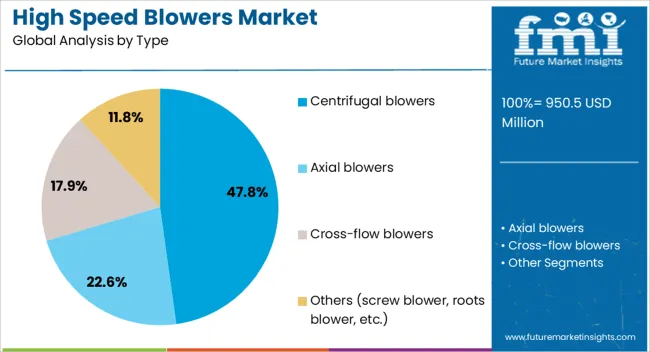
Centrifugal blowers are expected to contribute 47.80% of the total market revenue in 2025, positioning them as the leading product type. This segment's dominance is being supported by their superior efficiency in delivering high airflow at low-to-medium pressure, making them ideal for diverse industrial applications.
Their simple design, low maintenance needs, and ability to handle variable load conditions have enhanced deployment in facilities requiring consistent performance. Centrifugal blowers are especially favored in large-scale operations such as aeration, ventilation, and combustion air supply due to their proven operational reliability.
Their compatibility with noise and vibration-dampening technologies further strengthens adoption in urban installations and enclosed industrial environments.
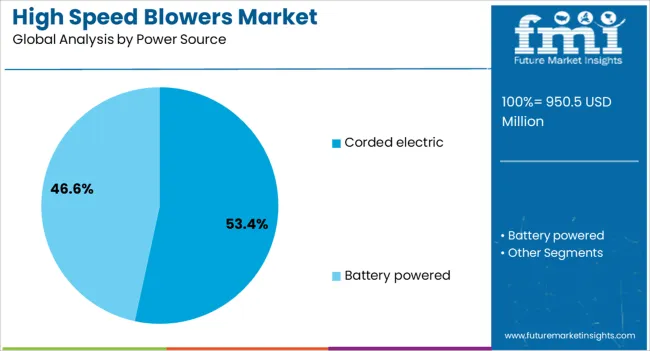
Corded electric high speed blowers are projected to account for 53.40% of the total market share in 2025, marking them as the primary power source in use. This leadership is attributed to their uninterrupted power delivery, which ensures stable and efficient blower performance in continuous-duty industrial settings.
Corded systems eliminate the limitations associated with battery capacity and charging downtime, making them highly reliable for 24/7 operations. Their ease of integration with centralized control systems and variable frequency drives also contributes to greater energy optimization.
As industries continue to prioritize operational uptime and cost efficiency, corded electric blowers remain a dependable solution across water treatment, manufacturing, and process sectors.
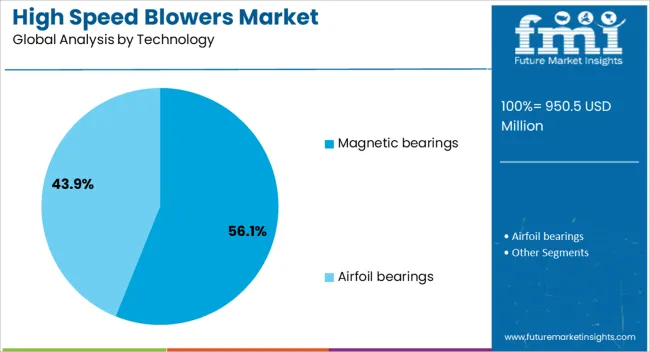
Magnetic bearings are anticipated to hold 56.10% of the market revenue in 2025, making them the leading technology segment. The rise in preference for magnetic bearings is being driven by their ability to eliminate mechanical friction, resulting in significantly reduced wear and longer service life.
These systems also support higher rotational speeds and offer superior energy efficiency compared to traditional bearing technologies. The oil-free operation enabled by magnetic systems aligns with stringent contamination control and maintenance reduction goals in industries such as pharmaceuticals, electronics, and clean water applications.
In addition, advancements in real-time monitoring and smart diagnostics are enhancing their appeal among end users seeking high precision and low-maintenance solutions.
The High-Speed Blowers Market is driven by industrial demand, energy efficiency, technological advancements, and regulatory compliance. These factors collectively ensure the sustained growth of the market.
The High-Speed Blowers Market continues to experience robust demand across several industrial applications. High-speed blowers are essential in sectors such as manufacturing, chemical processing, and wastewater treatment, providing efficient airflow for ventilation, cooling, and material handling. Industries are increasingly adopting these blowers due to their energy efficiency, which allows for reduced operational costs. Their use in industries like cement, mining, and food processing further solidifies their role in industrial production processes. The increasing complexity of industrial operations and the need for optimized air supply systems have enhanced the demand for high-speed blowers, positioning them as critical components in many large-scale facilities.
Energy efficiency remains a key driver for the High-Speed Blowers Market. As industries focus on reducing energy consumption and operational costs, high-speed blowers stand out due to their ability to operate efficiently at higher speeds, consuming less power compared to traditional blowers. With energy costs continuing to rise, companies seek solutions that offer long-term savings. The adoption of energy-efficient blowers not only reduces costs but also meets regulatory requirements for energy consumption. By optimizing airflow and reducing power usage, these blowers provide a competitive advantage, allowing businesses to maintain cost-efficiency while improving overall performance and productivity.
As regulatory standards for energy efficiency and emissions tighten, high-speed blowers have become increasingly relevant due to their ability to meet these demands. Stricter environmental regulations and energy consumption requirements across various industries push companies to adopt blowers that comply with both national and international standards. High-speed blowers are particularly advantageous in sectors like power plants and wastewater treatment, where compliance with environmental and operational standards is critical. These blowers offer an efficient solution, helping companies meet compliance goals while improving performance. The market is expected to benefit from continuous regulatory changes, as industries seek reliable solutions that ensure compliance without compromising productivity.
Regulatory standards for energy consumption, air quality, and industrial processes are influencing the High-Speed Blowers Market. Governments worldwide are implementing stricter regulations on energy efficiency and environmental impacts, which are pushing industries to adopt more sustainable practices. High-speed blowers, known for their energy-efficient operations, help companies comply with these regulations while maintaining performance. Additionally, blowers used in wastewater treatment and air quality systems must meet specific emission standards, further driving demand for high-speed solutions. As industries face increasing pressure to reduce their environmental footprint, the adoption of high-speed blowers is seen as a reliable solution to meet compliance standards without sacrificing operational efficiency.
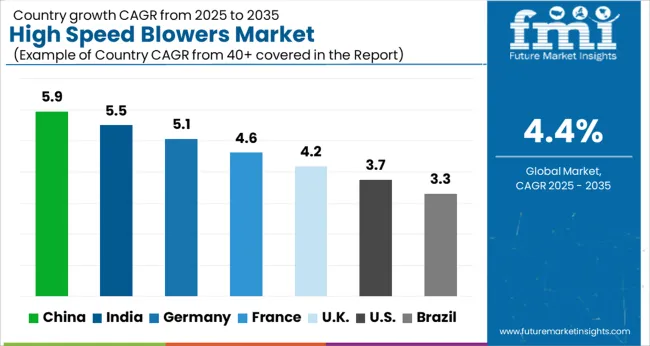
The high-speed blowers market is projected to grow globally at a CAGR of 4.4% from 2025 to 2035, driven by increasing demand across various sectors such as wastewater treatment, HVAC systems, and industrial ventilation. China leads with a CAGR of 5.9%, supported by rapid industrial growth, urbanization, and increasing demand for high-speed blowers in manufacturing processes. India follows at 5.5%, driven by expanding industrialization, increasing construction activities, and rising adoption of efficient ventilation systems. France grows at 4.6%, benefiting from strong demand in industrial applications, especially in water and air treatment industries.
The United Kingdom achieves a CAGR of 4.2%, supported by a steady market demand for energy-efficient air circulation systems in commercial and residential sectors. The United States records a CAGR of 3.7%, driven by technological advancements in blower systems, steady industrial demand, and environmental regulations encouraging energy-efficient solutions. This growth trajectory reflects the increasing reliance on high-speed blowers for industrial ventilation and environmental sustainability, highlighting their importance in improving air quality, energy efficiency, and overall system performance.
The UK’s high-speed blowers market grew at a CAGR of 3.1% from 2020 to 2024 and is expected to rise to 4.2% during 2025-2035. The earlier growth was moderate, with increasing demand driven by industrial applications like HVAC systems, wastewater treatment, and ventilation in commercial buildings. However, the market is projected to experience a rise in the coming decade due to rising energy efficiency demands, government regulations on air quality, and technological advancements in blower systems. The UK’s focus on sustainability and eco-friendly solutions will further promote the demand for energy-efficient high-speed blowers. As industries transition to more energy-efficient technologies, the market for high-speed blowers is expected to accelerate.
China’s high-speed blowers market is projected to grow at a CAGR of 5.9% from 2025 to 2035, surpassing the global CAGR of 4.4%. The market grew at a CAGR of 4.8% during 2020-2024, supported by the rapid expansion of industrial infrastructure, particularly in the manufacturing and wastewater sectors. The expected acceleration in the coming decade is attributed to China’s continued urbanization, industrial growth, and rising demand for energy-efficient and sustainable blower systems. The government’s focus on environmental regulations and improving air quality will further drive demand for high-speed blowers, especially in industrial processes and wastewater treatment plants.
India’s high-speed blowers market is expected to grow at a CAGR of 5.5% during 2025-2035, higher than the global average of 4.4%. The market grew at a CAGR of 4.3% from 2020 to 2024, supported by the country’s growing industrial base, urbanization, and increasing demand for ventilation solutions in manufacturing, wastewater, and HVAC systems. The rise in industrial applications, coupled with increased government efforts to improve air quality and efficiency in manufacturing processes, will accelerate market growth in the next decade. As India continues to develop its industrial infrastructure, demand for energy-efficient high-speed blowers will rise.
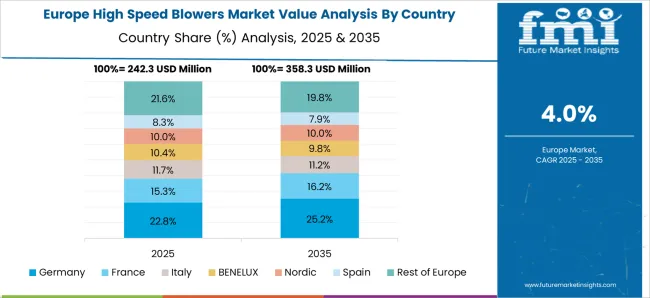
France’s high-speed blowers market is expected to grow at a CAGR of 4.6% from 2025 to 2035. The market grew at a CAGR of 3.8% during 2020-2024, driven by demand from the industrial, commercial, and environmental sectors. France’s strong focus on energy efficiency and environmental sustainability has led to higher adoption of energy-efficient systems in HVAC, wastewater, and air treatment processes. The coming decade will see stronger growth as businesses and industries shift toward more sustainable technologies, and government regulations push for reduced energy consumption and improved air quality. The trend towards eco-friendly solutions and increasing investments in infrastructure will further drive the market for high-speed blowers.
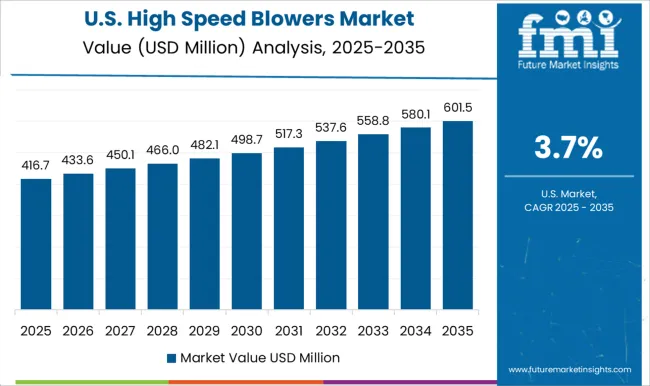
The USA high-speed blowers market is projected to grow at a CAGR of 3.7% during 2025-2035. The market grew at a CAGR of 3.2% during 2020-2024, supported by demand for ventilation systems in industrial applications, particularly in wastewater treatment and HVAC systems. The growth rate in the next decade will be driven by rising demand for energy-efficient solutions, technological improvements in blower systems, and government regulations targeting energy consumption and air quality. As the USA manufacturing sector continues to adopt more efficient and environmentally-friendly technologies, the market for high-speed blowers will grow. Moreover, innovations in blower design and performance will further support demand.

The High-Speed Blowers Market is influenced by key players such as Atlas Copco AB, Aerzen Turbo Co., Ltd., and Gardner Denver Inc., who lead the competition with their focus on performance, reliability, and cost-effective solutions. Atlas Copco AB is known for its energy-efficient, high-performance blowers, catering to diverse industries including mining, cement, and HVAC. Aerzen Turbo Co., Ltd. excels with its rotary lobe and screw blower technologies, offering high-speed solutions for applications requiring high airflow and low energy consumption.
Gardner Denver Inc. provides innovative, energy-saving blowers with advanced control systems, ensuring precise airflow and improved process efficiency. Other prominent players such as Spencer Turbine Company, Howden North America, Inc., and United Blower Inc. emphasize specialized blower systems for industrial sectors like food processing, pharmaceuticals, and water treatment. These companies focus on meeting the rigorous demands of high-flow, low-noise, and durable solutions.
Xylem Inc. and Zi-Argus Ltd. contribute advanced blower technologies tailored to the needs of the energy and environmental sectors, where high-speed blowers are essential for power plant operations and wastewater treatment. Additional companies like Eminent Blowers, Esurging (Tianjin) Technology Co., Ltd., and Nanjing Magnetic Valley Technology Co., Ltd. are gaining traction in niche markets, offering customized blower solutions that address specific industry requirements. These players focus on performance optimization, ensuring their products meet the diverse needs of industries such as automotive, chemical, and HVAC.
Companies are developing energy-efficient high-speed blowers to reduce operational costs and carbon footprints. Many manufacturers are focusing on the design of low-energy consumption models that provide superior airflow while minimizing energy waste, driven by the increasing demand for sustainable industrial solutions.
Manufacturers are using advanced materials like ceramics and composites to enhance the durability and performance of high-speed blowers. These materials help improve the service life and resilience of blowers, especially in harsh or abrasive environments, such as in mining or grain handling applications.
| Item | Value |
|---|---|
| Quantitative Units | USD 950.5 Million |
| Type | Centrifugal blowers, Axial blowers, Cross-flow blowers, and Others (screw blower, roots blower, etc.) |
| Power Source | Corded electric and Battery powered |
| Technology | Magnetic bearings and Airfoil bearings |
| Application | Wastewater treatment, Oil & gas, Chemical, Marine, Food & beverages, and Others (pulp and paper, food and beverage, etc.) |
| Distribution Channel | Direct sales and Indirect sales |
| Regions Covered | North America, Europe, Asia-Pacific, Latin America, Middle East & Africa |
| Country Covered | United States, Canada, Germany, France, United Kingdom, China, Japan, India, Brazil, South Africa |
| Key Companies Profiled | Atlas Copco AB, Aerzen Turbo Co., Ltd, APG Neuros, Inc, Atlantic Blower, Continental Industries, Eminent Blowers, Esurging (Tianjin) Technology Co., Ltd, Gardner Denver Inc., Houston Service Industries Inc, Howden North America, Inc, Nanjing Magnetic Valley Technology Co Ltd, Spencer Turbine Company, United Blower Inc, Xylem Inc, and Zi-Argus Ltd |
| Additional Attributes | Dollar sales trends across key regions and sectors. They would also want to understand the market share of top players and emerging competitors to gauge their position in the industry. Knowledge about growth drivers and challenges in various industrial sectors would be crucial, along with information on technological innovations that could impact demand. |
The global high speed blowers market is estimated to be valued at USD 950.5 million in 2025.
The market size for the high speed blowers market is projected to reach USD 1,462.1 million by 2035.
The high speed blowers market is expected to grow at a 4.4% CAGR between 2025 and 2035.
The key product types in high speed blowers market are centrifugal blowers, axial blowers, cross-flow blowers and others (screw blower, roots blower, etc.).
In terms of power source, corded electric segment to command 53.4% share in the high speed blowers market in 2025.






Our Research Products

The "Full Research Suite" delivers actionable market intel, deep dives on markets or technologies, so clients act faster, cut risk, and unlock growth.

The Leaderboard benchmarks and ranks top vendors, classifying them as Established Leaders, Leading Challengers, or Disruptors & Challengers.

Locates where complements amplify value and substitutes erode it, forecasting net impact by horizon

We deliver granular, decision-grade intel: market sizing, 5-year forecasts, pricing, adoption, usage, revenue, and operational KPIs—plus competitor tracking, regulation, and value chains—across 60 countries broadly.

Spot the shifts before they hit your P&L. We track inflection points, adoption curves, pricing moves, and ecosystem plays to show where demand is heading, why it is changing, and what to do next across high-growth markets and disruptive tech

Real-time reads of user behavior. We track shifting priorities, perceptions of today’s and next-gen services, and provider experience, then pace how fast tech moves from trial to adoption, blending buyer, consumer, and channel inputs with social signals (#WhySwitch, #UX).

Partner with our analyst team to build a custom report designed around your business priorities. From analysing market trends to assessing competitors or crafting bespoke datasets, we tailor insights to your needs.
Supplier Intelligence
Discovery & Profiling
Capacity & Footprint
Performance & Risk
Compliance & Governance
Commercial Readiness
Who Supplies Whom
Scorecards & Shortlists
Playbooks & Docs
Category Intelligence
Definition & Scope
Demand & Use Cases
Cost Drivers
Market Structure
Supply Chain Map
Trade & Policy
Operating Norms
Deliverables
Buyer Intelligence
Account Basics
Spend & Scope
Procurement Model
Vendor Requirements
Terms & Policies
Entry Strategy
Pain Points & Triggers
Outputs
Pricing Analysis
Benchmarks
Trends
Should-Cost
Indexation
Landed Cost
Commercial Terms
Deliverables
Brand Analysis
Positioning & Value Prop
Share & Presence
Customer Evidence
Go-to-Market
Digital & Reputation
Compliance & Trust
KPIs & Gaps
Outputs
Full Research Suite comprises of:
Market outlook & trends analysis
Interviews & case studies
Strategic recommendations
Vendor profiles & capabilities analysis
5-year forecasts
8 regions and 60+ country-level data splits
Market segment data splits
12 months of continuous data updates
DELIVERED AS:
PDF EXCEL ONLINE
High Speed Rolling Bearings Market Size and Share Forecast Outlook 2025 to 2035
High-Speed Steel Metal Cutting Tools Market Size and Share Forecast Outlook 2025 to 2035
High-Speed Interconnects Market by Type by Application & Region Forecast till 2035
High Speed Steel (HSS) Tools Market Growth - Trends & Forecast 2025 to 2035
High-speed Engine Market Growth – Trends & Forecast 2024-2034
High Speed Data Converters Market
High Frequency High Speed Copper Clad Laminate CCL Market Size and Share Forecast Outlook 2025 to 2035
Commercial High-Speed Oven Market Size and Share Forecast Outlook 2025 to 2035
Rapid Cook-High Speed Ovens Market
Fully Automatic High Speed Nail Making Machine Market Size and Share Forecast Outlook 2025 to 2035
High Protein Powders Market Analysis - Size, Share, and Forecast Outlook 2025 to 2035
High Purity Gas Flow Meter Market Size and Share Forecast Outlook 2025 to 2035
High Purity Flow Meter Market Size and Share Forecast Outlook 2025 to 2035
High Performance Permanent Magnet Market Size and Share Forecast Outlook 2025 to 2035
High Airtight Storage Cabinets Market Size and Share Forecast Outlook 2025 to 2035
High Voltage Porcelain Bushing Market Size and Share Forecast Outlook 2025 to 2035
High Purity Process Systems for Semiconductor Market Size and Share Forecast Outlook 2025 to 2035
High Octane Racing Fuel Market Size and Share Forecast Outlook 2025 to 2035
High Voltage Air-cooled Battery Compartment Market Size and Share Forecast Outlook 2025 to 2035
High Temperature NiMH Battery Market Size and Share Forecast Outlook 2025 to 2035

Thank you!
You will receive an email from our Business Development Manager. Please be sure to check your SPAM/JUNK folder too.
Chat With
MaRIA